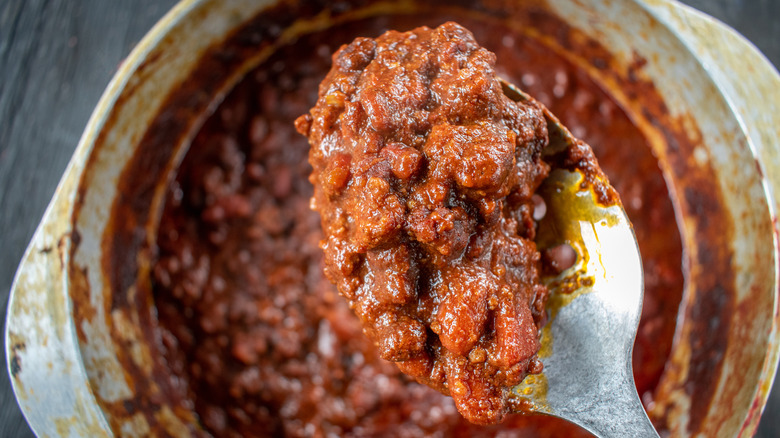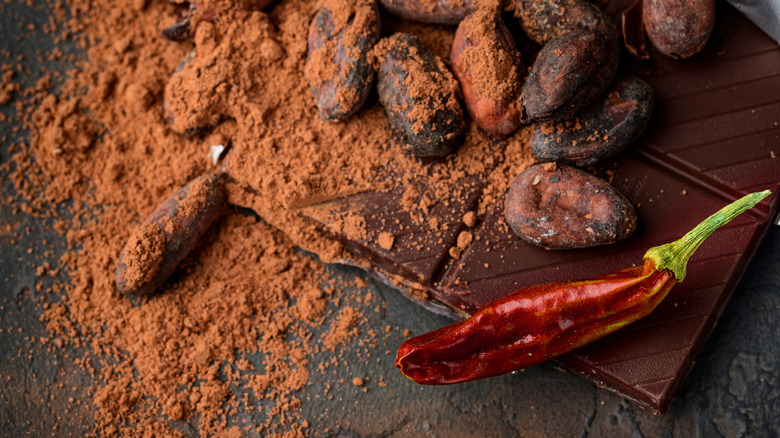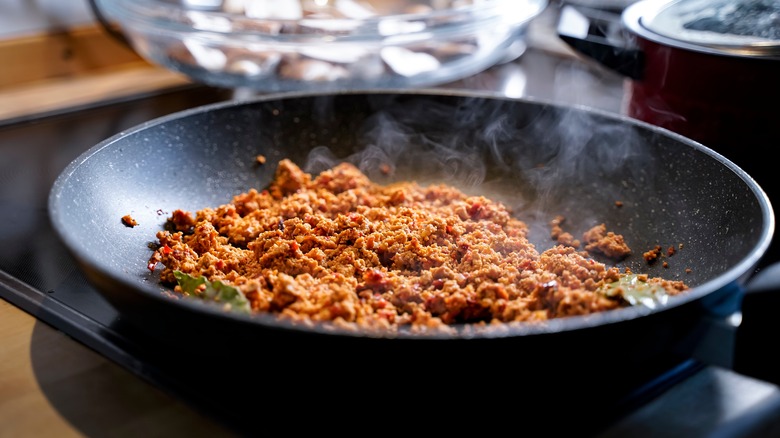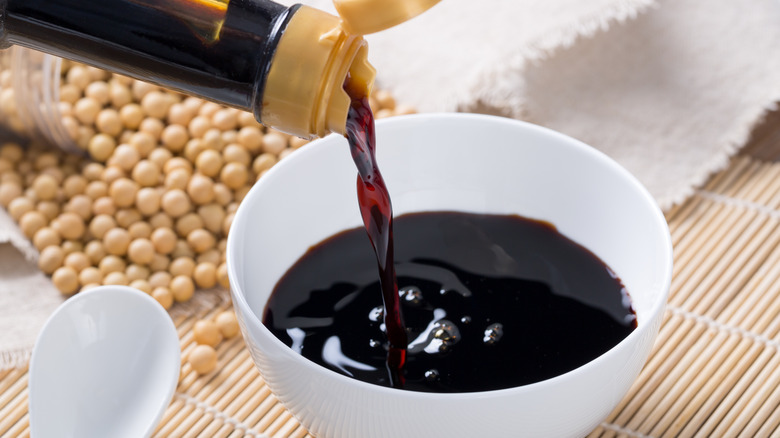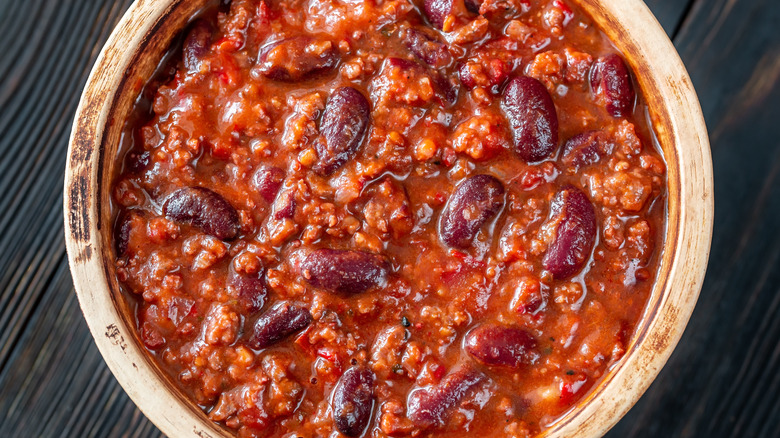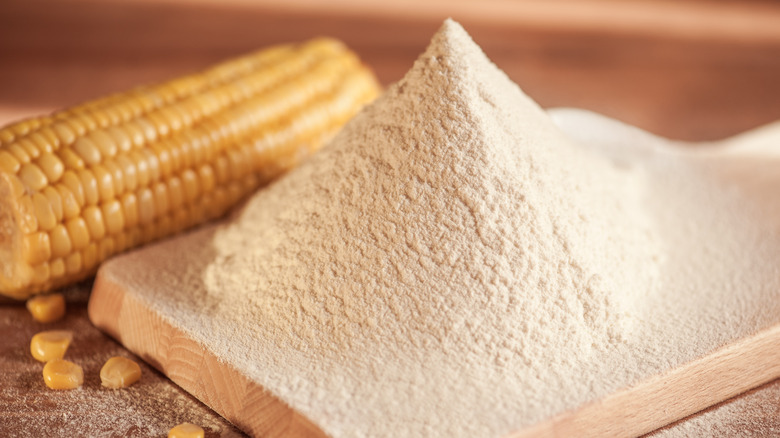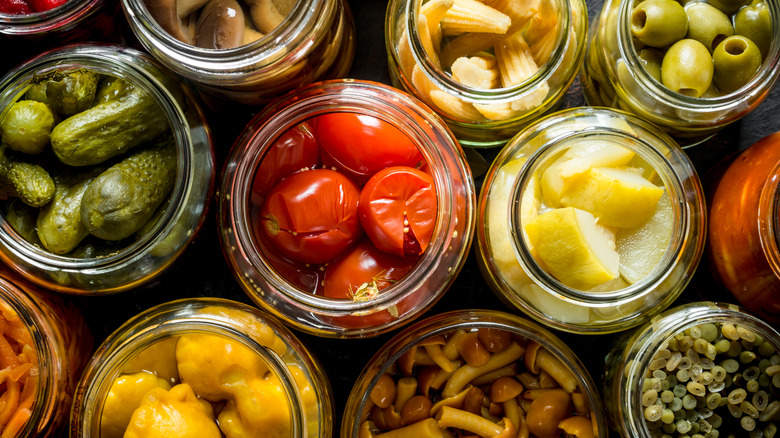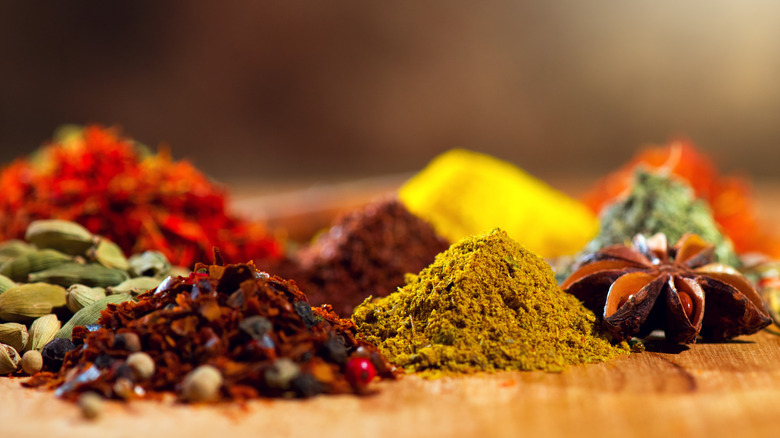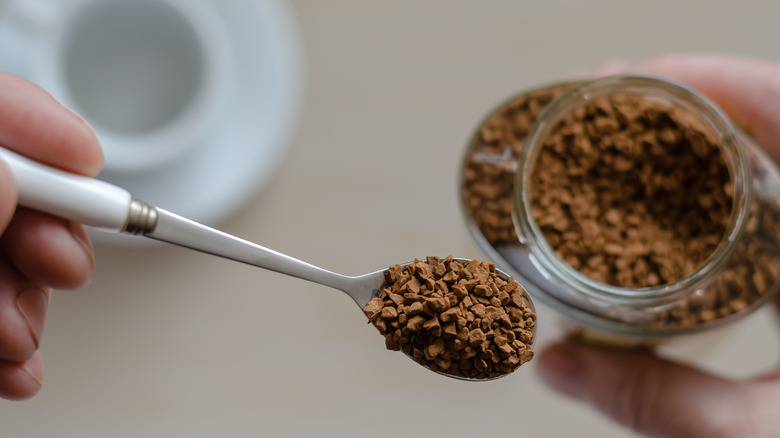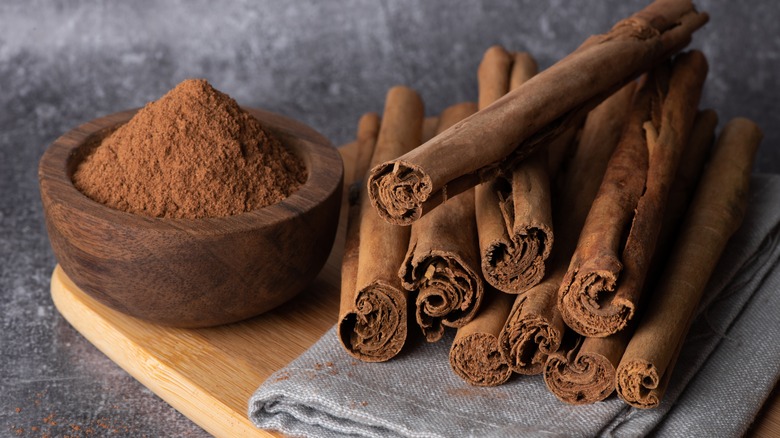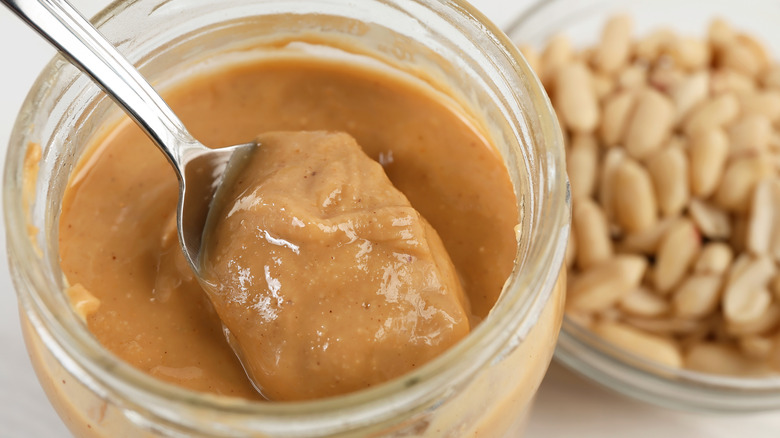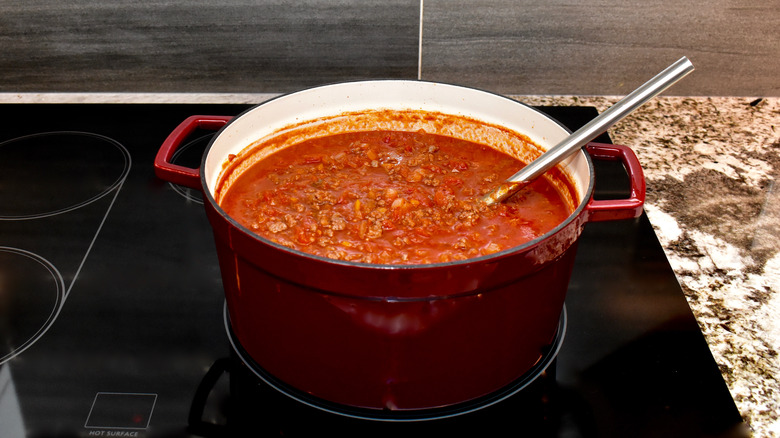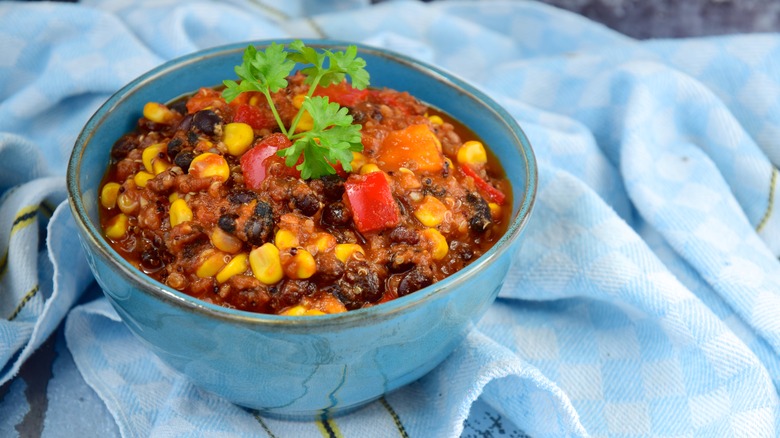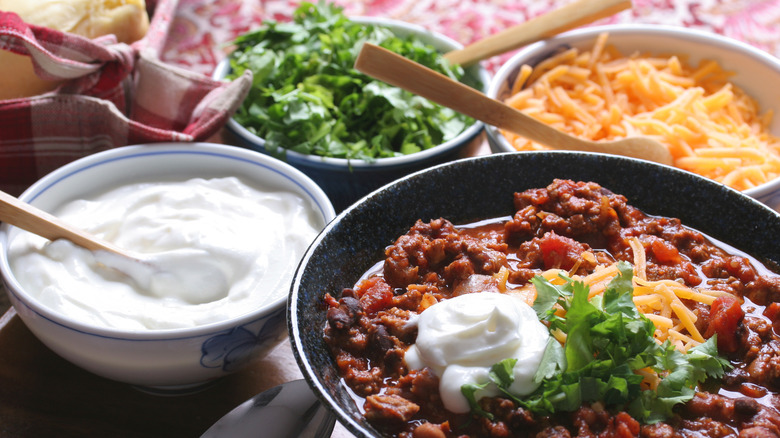17 Best Tips To Know That Will Elevate Your Next Batch Of Chili
Everyone seems to have their own special spin on chili, be it a "secret" ingredient addition or a unique cooking hack. Some are real game-changers, while others don't really add a whole lot of punch. Whether you're relying on a recipe that is passed down through countless generations or simply spur-of-the-moment inspiration, one thing is clear: Chili is one of those everything-but-the-kitchen-sink recipes that everyone thinks they do best.
The truth about chili is that it's all about flavor, texture, and adding your own flair. If you're looking for a recipe that perfectly fits your personal preference, we've rounded up the best tips to know that will elevate your next batch of chili, and some of them are pretty wild. Don't be surprised if you choose a few of these preparation tricks and ingredient additions to pass down through the generations, and deem your very own secret technique. That's okay, it's why we are sharing them with you!
Stir in cocoa powder
A major appeal of chili is its richness, depth, and overall heartiness. It's a conglomerate of ingredients that pair beautifully with one another. While vegetables, beans, and meat tend to make the cut, an unexpected ingredient that will change your chili forever is cocoa powder.
Cocoa powder has been harvested in South America for centuries, starting with the Olmecs, per Spiceography. Soon to follow were the Mayans and Aztecs, and then eventually the Spanish who shared the secrets of chocolate throughout Europe. Traditionally, the beans were fermented, dried, and used for the first versions of drinking chocolate which now hold traditions around the world.
Just a few tablespoons of cocoa powder (or even a few squares of a dark chocolate bar) can give your pot of chili that extra level of depth you've been searching for. Cocoa has a rich and creamy mouthfeel and can give your chili a nutty, floral, and even raisin-like flavor. While this may seem like an odd pick, cocoa trees are from the same region of the world as most other chili ingredients. Plants that grow together, often complement each other and this is certainly the case here as the cocoa powder will add a welcome depth of flavor and help cut through any heat.
Brown your meat
Although slow cooker chili might seem like the way to go, the added ease might not be worth the decreased quality. Yes, it's everyone's dream to throw a bunch of meat, vegetables, and spices into a big pot, pour a little broth over the top, and push a button. But to ensure your chili is of peak quality, it's important to take your time, and pull your creation together step by step.
The reason you need to brown the meat for chili is so that you are able to take full advantage of the Maillard reaction, which happens when raw meat comes in contact with a dry surface like a pan, open flame, or skillet and the meat becomes scalded. This process, as opposed to boiling or steaming, helps to lock in the juices, enhances the overall flavor by bringing out a natural sweetness, and provides welcome crispy and chewy textures.
Up the umami with soy sauce
The fifth and newest recognized taste, umami, is difficult to describe. It adds a level of savory depth to all that it touches, and recipes do not seem complete without it. Tomato paste, soy sauce, seaweed, parmesan, and mushrooms share that intangible quality that we call umami. While those simmering tomatoes in your chili bring a level of umami, adding a little power-packed kick with soy sauce adds a nice balance to the mix.
Instead of opting for salt, try going 50/50 with soy sauce, or the gluten-free alternative of tamari. You can even go all in and use it as your main source of salt. This swap will give your chili a level of depth and complexity that will be difficult for you to put your finger on but could make all the difference. This swap is particularly important if you plan to make your chili vegetarian.
Mix in balsamic vinegar
For a rounded mouthfeel, it's important to include an element of acid in each and every dish you make. This could mean a citrus fruit, vinegar, or brine. Most of the time, when you take a sample bite and think that it's missing something, the answer is usually some form of acid.
Adding balsamic vinegar makes the cut for the best tips to know that will elevate your next batch of chili because it not only contains that element of acid but also has a rich sweetness to it. Just like pasta marinara pairs beautifully with a glass of red wine, tomato-rich chili couples well with balsamic vinegar bridging fruitiness and savoriness. Just remember to apply in small quantities since a little can go a long way. Along with a spritz of lime juice, balsamic can finish out that rounded mouthfeel, and elevate the flavors already in the pot. Give it a splash next time you make homemade chili.
Bring the campfire indoors with liquid smoke
In an ideal world, chili would be cooked over an open flame atop a mountain in Montana But if you can pull off preparing a pot of beef and beans in the great outdoors, there are other ways to give our chili that authentic, campfire-cooked appeal.
Liquid smoke makes any dish taste, you guessed it, smokey. With each bite, you will be transported into cowboy country, a tin of black coffee in hand, and the big open sky at your back. Well, maybe it won't actually teleport you, but it will certainly take on the flavor of a flame-cooked meal.
Liquid smoke comes in a variety of flavors, so take a whiff of it before adding it in little by little. Smoked paprika can also help to create the illusion of a smokey open fire, and adds a pleasing sweet flavor and deep red color to the mix as well. You'll wish you made chili like this sooner.
Select your beans carefully
Though not an essential component of chili, beans are often a favored ingredient. But before you start adding those legumes, it's important to distinguish what types of beans are best for chili. Although you really can just throw any old bean into the mix, taking your time and being selective can drastically change the outcome. Creamy beans like kidney beans, black beans, and pinto beans make the perfect addition to any chili. We prefer to cook dry beans right into the sauce, but canned beans will work just fine in a pinch. In fact, that starchy bean water can help to thicken the liquids naturally.
Although beans mix flawlessly with any meat, consider making a vegan chili featuring the beans themselves. Load on the vegetables, at least three kinds of beans, and plenty of spices to go around. This plant-protein-rich main dish is an all-time favorite and is universally loved by vegetarians, vegans, and meat-eaters alike.
Stir in masa harina for thicker chili
There is nothing worse than runny chili. After all, it's not a soup and should be thick and hearty rather than thin and slurpable. Chili is its own category and should pile up high on a spoon. Even after hours of simmering, if you're finding that the base is far too thin to recover, you may need to add an additional ingredient for thicker more flavorful chili.
Masa harina is simply finely ground cornmeal. It's subtle in flavor and can help to thicken the broth without changing the overall flavor of the recipe. In fact, because corn is often a chili ingredient or topping, it can actually add an element of familiarity to the mix. Simply combine with equal parts water and stir into your chili. So before you start straining out the liquid and losing precious flavor, try turning to masa harina before taking such drastic measures.
Pucker up for pickling liquids
Just like balsamic vinegar provides an element of acid to chili, so does pickling brine. This addition comes in handy, especially when using canned ingredients pickled jalapenos or pickled green chilis to chili. Don't bother straining it, just dump the whole can right in.
If you're lucky enough to have pickle-habanero or spicy pepper brine on hand, be sure to add a few tablespoons to your recipe. While your standard pickle brine works just fine, sweet or dill alike, options with garlic, mustard seed, and some element of spice tend to blend in best. Even pickled beet brine has been known to add an element of acid and sweetness to the pot that helps to bring out existing flavors.
If you're not ready to open a whole jar of pickles just for a few tablespoons, consider adding pickled red onion brine, and saving the onions as a chili topping along with cilantro, green onion, and sour cream.
Choose a flavorful sweetener
White sugar is so last year. What does it bring to the table besides sweetness? Really, it doesn't have much flavor, so if we are going to add a sweetener, let's add one with some pizzazz. There are plenty of other sweet additions that will change your chili forever. Consider using brown sugar for a richer flavor, or go one step further by adding molasses. We highly recommend upgrading your chili with maple syrup which sweetens chili beautifully and adds an almost smokey caramel flavor.
If you're making whole-food chili, consider using date paste or date sugar. The flavor closely mimics that of molasses, and it's loaded with natural nutrients and fiber.
If you want to opt-out of adding a sweetener and have some time on your hands, let the tomatoes simmer for several hours. When the liquid cooks off, add broth or water, and cook it down again. This will help to cook off any acid and bring out the natural sugars in the tomatoes.
Don't skimp on the herbs and spices
That six-ingredient chili that popped up on your search may promise you a delicious flavor, but the truth is, it's never okay to skimp on the herbs and spices. The biggest mistake that you can make with chili is to under-spice it. Chili should be flavorful, aromatic, spicy, and packed to the brim with a variety of flavors and levels of depth.
If you're not ready to get all of your spices out of the cabinet each time you make a pot of chili, consider making an all-purpose chili seasoning mix. You can always add additional spices to taste, but this could give you a solid foundation to work from. Try adding spices like paprika, chili powder, cumin, coriander, Mexican oregano, garlic powder, onion powder, cinnamon, cayenne, or even chipotle. Prior to preparing your chili, check the expiration date on your dried herbs and spices. If they're too old, the flavor of your chili may suffer.
Booze it up
Beer is an ideal beverage pairing with chili, but it is also a great complement to the recipe itself. The heavier the better, and even flavored beers like pumpkin ale or citrus IPAs can contribute to the overall flavor. Remember, the alcohol will cook off, but the remaining flavor can make all the difference.
Another way to use alcohol in your chili is by deglazing the pan with it. There is a reason that top chefs take this step, and that's because all of those caramelized, concentrated bits that are stuck to the bottom of the pan pack a punch of flavor and should not go to waste. Instead of using water, a touch of booze will add another layer of depth to your creation and helps to prolong the flavors and aromas.
Seriously, your chili will taste even better with this one simple ingredient. Consider beer, red wine, hard cider, or even whiskey, to deglaze the pan. The alcohol will cook off quickly and will enhance the natural sugars and flavors of all the caramelized bits.
Pour in some instant coffee
Many people swear by this unusual chili ingredient and claim that their recipe couldn't be complete without a hint of that smokey, nutty flavor that comes from coffee. And we agree! There are several ways to infuse your chili with America's favorite beverage, but the easiest one perhaps is to add espresso powder or instant coffee right into the pot. Heck, if you're feeling generous pour some of your own morning brew right into the pan and let the excess liquid cook off.
Coffee can majorly upgrade your chili because it can add another layer of depth while including an earthy and aromatic element of flavor. The rustic, smooth yet bitter flavor adds a zing that is difficult to otherwise obtain. This addition will also help to give your broth depth, color, and richness. The familiar flavor will excite your tastebuds and will elevate your next batch of chili.
Sprinkle in baking spices
Spices typically used for sweet treats like cinnamon, nutmeg, and cloves can give your chili a warming, unique flavor. Consider using them in moderation, and adding each one little by little. Cloves and nutmeg have an especially intense flavor, so it's important to make a small test cup by scooping out some of your chili into a separate bowl and adding a pinch of the spice for a taste test. The spices will blossom over time, so add less than you think you need.
Cinnamon, on the other hand, has quite a bit of experience when it comes to flavoring meat. What makes moussaka unique is the spice combination of oregano and cinnamon to delicately flavor the lamb. Similarly, cinnamon can be used along with your meat or beans in chili. Adding warming spices to your chili will help to reinforce that few dishes are better suited for cold weather eating.
Make it rich with peanut butter
So, you've made the perfect pot of chili, packed it up overnight in the refrigerator, and you've begun the reheating process. That first bite is out of this world, as the spices have bloomed overnight, but that spiky kick knocks you off your feet. It wasn't quite so spicy yesterday, but after sitting overnight it's a little too much to handle. Before you try to dilute it with broth or tomato juice, consider going with a tried and true sandwich spread.
Yep, peanut butter is here to save the day! Peanut butter is an excellent neutralizer of spices. Capsaicin, the compound that makes food spicy, is fat-soluble and reacts to peanut butter in a similar way it does to milk.
Peanut butter not only helps to neutralize spice but also makes the broth creamy and rich. The flavor pairs beautifully with every chili ingredient, and it can be a last-minute lifesaver for those who are spice-sensitive.
Simmer it as long as you can
We don't care if the recipe you found online for "quick and easy chili" tells you that you can simmer the ingredients in under an hour. They're wrong. Chili should simmer for an hour at the absolute minimum, and no good chili can be rushed. If you're wondering how long you should be cooking your chili, our answer is the more the time, the better. Keep your temperature low. A light simmer will do the trick without overly toughening the meat, or overcooking the vegetables.
The benefit of simmering chili for an extended period of time is to cook off the amount of acid in the tomatoes and bring out the natural sugars. The longer it simmers, the sweeter it will get. If you're planning on simmering the chili for an extended period of time, be methodical about when you add your ingredients. Save the softer vegetables for later in the game, and start with just your tomato base, meats, spices, onions, and garlic. Simmer away!
Expand your vegetable roster
Although sugar doesn't come to mind when thinking about chili, sweetness is actually quite an important component. Luckily, most of these sugars can come from vegetables (another food group that doesn't necessarily ring the dessert bell). Think about it, we get most of our sugar from corn and beets, and both are vegetables.
Onions, red peppers, corn, and sweet potatoes are all incredible sources of sweetness for savory dishes. In addition, vegetables give chili a variety of flavors and textures. When cooked, vegetables soak up the flavors around them, and their sugars begin to break down and contribute to the entirety of the dish. While onions and garlic are often a given, other vegetables are commonly overlooked. If you'd rather not add too many vegetables to the mix, remember that grilled corn, diced red pepper, raw red onion, and roasted sweet potato all make incredible chili toppings.
Load on the toppings
Chili is really an art and the grand finale of creativity reaches its peak when it comes time to load up at the toppings bar. Chili is heavy, intense, and rich. A large bowl of chili can become monotonous, so it's important to break up the flavor and texture with toppings. Variety is the spice of life, so it's important to have varying temperatures, textures, and flavors in each and every bite.
For instance, green onions, cilantro, lime, tortilla chips, and avocado are all fresh and flavorful and complement hot, tangy chili nicely. Some are crunchy, while others are smooth or soft. Coconut milk, sharp cheddar cheese, greek yogurt, or sour cream can help to add a cool, creamy element that contrasts but complements the heat. Tangy elements like pickled onions or jalapenos can add a zestiness that helps to balance the richness and heaviness of the chili. A rounded mouthfeel and a variety of flavors can elevate your next batch of chili.
